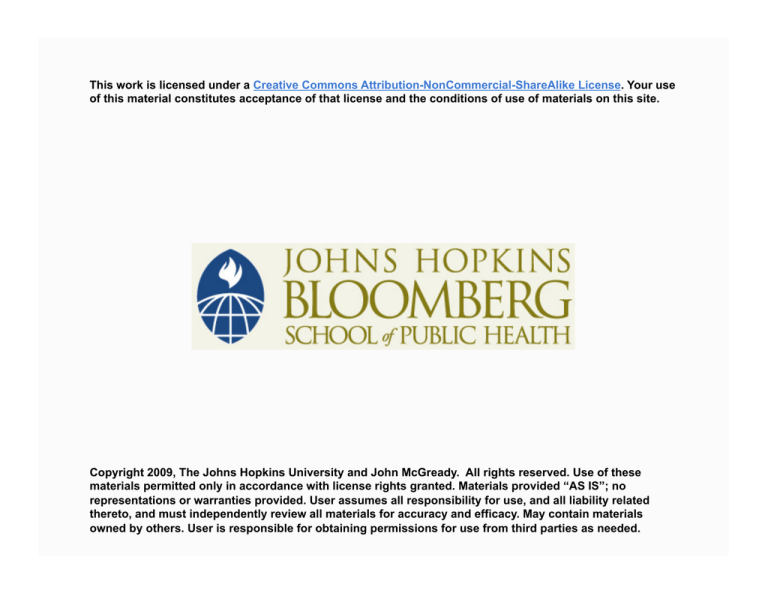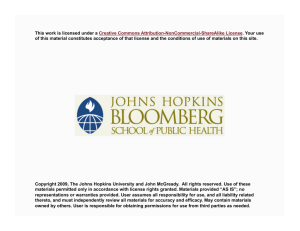
This work is licensed under a Creative Commons Attribution-NonCommercial-ShareAlike License. Your use
of this material constitutes acceptance of that license and the conditions of use of materials on this site.
Copyright 2009, The Johns Hopkins University and John McGready. All rights reserved. Use of these
materials permitted only in accordance with license rights granted. Materials provided “AS IS”; no
representations or warranties provided. User assumes all responsibility for use, and all liability related
thereto, and must independently review all materials for accuracy and efficacy. May contain materials
owned by others. User is responsible for obtaining permissions for use from third parties as needed.
Section C
Statistical Inference on Survival Curves
Comparing Survival Curves
The estimate survival curve
is just an estimate based on a
sample from a larger population: how to quantify uncertainty on a
curve?
One approach: can put confidence intervals around each change
estimated at each event time
- This can be cumbersome to read/interpret when there are many
event times
- Not very efficient approach for comparing the survival curves
between multiple populations based on multiple random
samples (ex: drug versus placebo)
3
Comparing Survival Curves
Common statistical tests
- Generalized Wilcoxon (Breslow, Gehan)
- Log-rank
Both compare two survival curves across multiple time points to
answer the question—“is overall survival different between the
groups?”
- Ho : S1(t) = S2(t)
- HA : S1(t) ≠ S2(t)
4
Comparing Survival Curves
Wilcoxon (Breslow, Gehan) more sensitive to early survival
differences
Log-rank more sensitive to later survival differences
Both: compute difference between what is observed at each event
time and what would be expected under the null hypothesis
-
These differences are aggregated across all event times into
one overall “distance” measure (i.e., how far sample curves
differ from null after accounting for sampling variability)
-
The Wilcoxon and log-rank tests aggregate these event-time
specific differences slightly differently
-
Both tests give a p-value and generally these p-values are
similar
Neither
-
Give overall measure of association (like a relative risk, etc.) or
confidence interval
5
Examples of Logrank and Breslow-Gehan Test
Time to motion sickness*: simulation designed to measure impact of
intensity of prolonged vertical motion exposure on motion sickness
- Group 1 subjected (21 persons) to low vertical motion for up to
two hours
- Group 2 (28 persons) subject to high vertical motion for up to
two hours
- Event of interest motion sickness (first vomiting episode)
- Some subjects “dropped out” prior to the end of two hours
without vomiting
Note: * Example based on data taken from Altman, D. (1991). Practical statistical for medical research, 1st ed.
Chapman and Hall (based on research by Burns, K.C. (1990). Motion sickness . . . aviation space environmental
medicine, 56, 21-7.
6
Examples of Logrank and Breslow-Gehan Test
Time to motion sickness
- Kaplan-Meier curves for time to motion sickness for each group,
with 95% CIs (hard to see, but these get wider with increased
time)
7
Examples of Logrank and Breslow-Gehan Test
Time to motion sickness
- Kaplan-Meier curves for time to motion sickness for each group,
without 95% CIs
8
Testing VM Intensity/Motion Sickness Relationship
Hypothesis test setup
- Ho: SLVM(t) = SHVM(t)
- HA: SLVM(t) ≠ SHVM(t)
Log-rank results:
- p = .073
Breslow/Wilcoxon/Gehan results:
- p = .075
9
Examples of Logrank and Breslow-Gehan Test
Clinical trial: between January 1974 and May 1984 a double-blinded
randomized trial on patients with primary biliary cirrhosis (PBC) of
the liver was conducted at the Mayo clinic (Rochester, MN)
- A total of 312 patients were randomized to either DPCA
(n = 154) or placebo (n = 158)
- Patients were followed until they died from PBC or until
censoring—either administrative censoring (withdrawn alive
at the end of the study), death not attributable to PBC, liver
transplantation, or lost to follow-up
10
Examples of Logrank and Breslow-Gehan Test
PBC trial
- Kaplan-Meier curves for time to death from PBC for each group,
with 95% CIs
11
Examples of Logrank and Breslow-Gehan Test
PBC trial
- Kaplan-Meier curves for time to death from PBC for each group,
without 95% CIs
12
Testing Drug/Survival Relationship
Hypothesis test setup
- Ho: SDPCA(t) = SPLACEBO(t)
- HA: SDPCA(t) ≠ SPLACEBO(t)
Log-rank results:
- p = .75
Breslow/Wilcoxon/Gehan results:
- p = .96
13
Examples of Logrank and Breslow-Gehan Test
PBC trial
- Kaplan-Meier curves for time to death from PBC for each group,
without 95% CIs
14
Testing Drug/Survival Relationship
Hypothesis test setup
- Ho: SDPCA(t) = SPLACEBO(t)
- HA: SDPCA(t) ≠ SPLACEBO(t)
Log-rank results:
- p = .75
Breslow/Wilcoxon/Gehan results:
- p = .96
15
Examples from Literature
Obstructive sleep apnea as a risk factor for stroke and death*
Subjects were followed until death or stroke (events) or censoring
- “In this observational cohort study, consecutive patients
underwent polysomnography, and subsequent events (strokes
and deaths) were verified. The diagnosis of the obstructive
sleep apnea syndrome was based on an apnea–hypopnea index
of five or higher (five or more events per hour); patients with
an apnea–hypopnea index of less than five served as the
comparison group.”
- “The Kaplan–Meier method and the log-rank test were used to
compare event-free survival among patients with and those
without the obstructive sleep apnea syndrome”
Notes: * Yaggi, H., et al. (2005). Obstructive sleep apnea as a risk factor for stroke and death. New England
Journal of Medicine, 353, 19.
16
Examples from Literature
Sleep apnea/death and stroke
17
Examples from Literature
Return to work following injury: The role of economic, social, and
job-related factors*
Subjects were followed until returning to work or censoring
- “The main dependent variable in the analysis is the time (in
days) from injury to the first time the study patient returned to
work. Kaplan-Meier estimates of the cumulative proportion of
patients returning to work were computed. These estimates
take into account how long patients were followed as well as
when they returned to work. A log-rank test was used to test
the association between the cumulative probability of RTW and
each of the risk factors considered one at a time.”
Notes: * MacKenzie, E., et al. (1998). Return to work following injury: The role of economic, social, and job-related
factors. America Journal of Public Health, 88, 11.
18
Examples from Literature
Kaplan Meier (tracking proportion HAVING event by time t,
as we previously defined it
19


